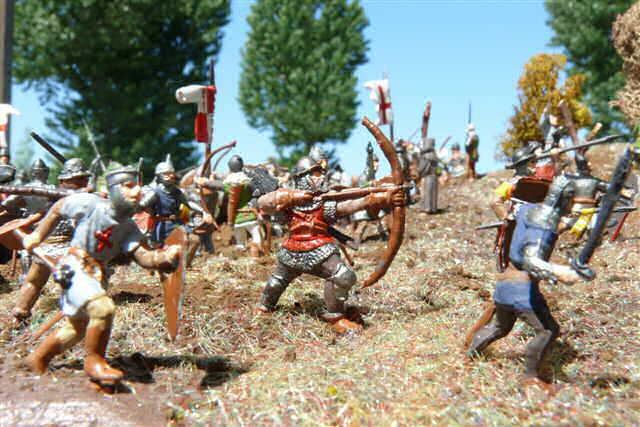Result Modenese victory | Date 15 November 1325 | |
 | ||
2,000 cavalry5,000 infantry 2,000 cavalry30,000 infantry Similar Battle of Fossalta, War of the Bucket, Battle of Colle Val d'Elsa, Battle of Pieve al Toppo, Battle of Desio | ||
The Battle of Zappolino (also known as the War of the Oaken Bucket) was fought in November 1325 between forces representing the Italian towns of Bologna and Modena, an incident in the series of raids and reprisals between the two cities that were part of the larger conflicts of Guelphs and Ghibellines. The Modenese were victorious. Though many clashes between Guelphs and Ghibellines loomed larger to contemporaries than to historians, in this unusually large encounter between 4000 estimated cavalry and some 35,000 foot soldiers, 2000 men lost their lives. The location of the battle, at the foot of a hill just outside the castle walls, is today a frazione of the municipality of Castello di Serravalle, Emilia-Romagna.
Contents
Setting
Though their boundaries had been set by Frederick II, Holy Roman Emperor, in person, a century before, competitive friction along their mutual marches between Ghibelline Modena, with the Emperor as patron, and Guelf Bologna, with the Pope as patron, had flared over decades. In 1296 the Bolognese successfully invaded the Modenese lands of Bazzano and Savigno, with the support of Pope Boniface VIII, who recognized in 1298 the Guelf possession of these border castles. Within the two cities the situation was complicated by numbers of exiles and divided loyalties. In Modena the struggle for power after the death of Obizzo II d'Este, which divided his sons' friends into hostile camps, was resolved in favour of Azzo VIII, who confronted Bologna in part to bolster his lukewarm reception by his own city's nobles. His elected successor, the Mantuan Passerino Bonacolsi, the agent of Louis of Bavaria, King of the Romans, pursued the embittered war politics, with Parma, Reggio and Modena also under his power. For his part John XXIII declared him a rebel against the Church, granting indulgences as befitted a Crusader to any who could harm his person or his possessions.
In the months before the battle, border clashes intensified. In July, the Bolognese entered Modenese territory and laid waste the fields in the section "between the canals", by fire and sword; in August a Bolognese rabble headed by their podestà spent two weeks ravaging the lands of Modena. In September the Mantuans took their turn, and at the end of that month, the strategic Bolognese rocca of Monteveglio was betrayed to Modena by malcontents; two renegade castellans were beheaded.
Battle
As the Bolognese chronicler Matteo Griffoni tells it, the militia and rabble of Bologna headed by their podestà, aided by allies from Florence and Romagna, besieged the fortress of Monteveglio. Quickly an opposing force arrived, headed by Cangrande della Scala, leader of the Ghibelline faction, Azzone Visconti of Milan, with many of his professional German troops, and Rinaldo, marchese of Ferrara, leading forces of Modena, Mantua and Ferrara. Cangrande soon departed for Verona, but the Bolognese took for their captain the condottiero Malatesta, lord of Rimini.
The battle took place 15 November 1325, towards sunset. The Bolognesi had 30,000 foot soldiers, who would have been haphazardly armed, and 2000 cavaliers, facing 2000 cavaliers on the Modenese side, supported by 5000 foot soldiers. The Ghibellini were arrayed on the plain where the frazione of Ziribega stands, while the Guelphs were on the slope descending from Bersagliera towards Zappolino, the Prati di Soletto surmounted by the castle. The Bolognese recalled men who had been drawn apart by a ruse, to Bazzano and Ponte Sant' Ambrogio. The aim was to stop the advance of the Modenese towards Monteveglio.
The battle was over by nightfall, within a couple of hours, with the Bolognese routed. The Modenese advanced to the very walls of Bologna, destroying the castles of Crespellano, Zola, Samoggia, Anzola, Castelfranco, Piumazzo and the chiusa del Reno near Casalecchio, which diverted the river towards the city. They did not attempt a siege of the city, but scornfully organized a palio outside the very gates of the city, ad æternam memoriam præmissorum et æternam Bononiensium scandalum, "to the eternal memory of those sent out on the expedition and the eternal shame of Bologna", and then returned to Modena brandishing a bucket taken from a well outside Porta San Felice; twenty-six captured notables of Bologna were incarcerated for the next eleven weeks in Modena.
Outcome
Though David Abulafia in The New Cambridge Medieval History asserts that "Ghibelline influence in the region was consolidated by a victory at Zappolino": peace agreements in the following January returned Monteveglio and the other castles to Bologna, a return locally to status quo ante that was probably paid for privately, as ransom, with coin in the hands of Passerino Bonacolsi. At Bologna, the coat of arms of Pope John XXII was displayed in conjunction with those of Robert d'Anjou, a mark that the old alliance of the Avignon papacy and the house of Anjou was still viable in some eyes. One of the bloodiest medieval battles had virtually no outcome and is largely ignored by historians.
The battle is also famous for the wooden bucket that the Modenese took as spoils from the Bolognesi. Though it is not mentioned by Griffoni, this unusual booty was venerated in Modena in remembrance of the victory. The history of the bucket was told in Alessandro Tassoni's satirical poem La Secchia Rapita (1614–15, published in Paris, 1622). It was still to be seen in the basement of the Torre della Ghirlandina in 1911. It was later replaced by a copy, while the original pail is still (2013) visible in Modena's Town Hall.
